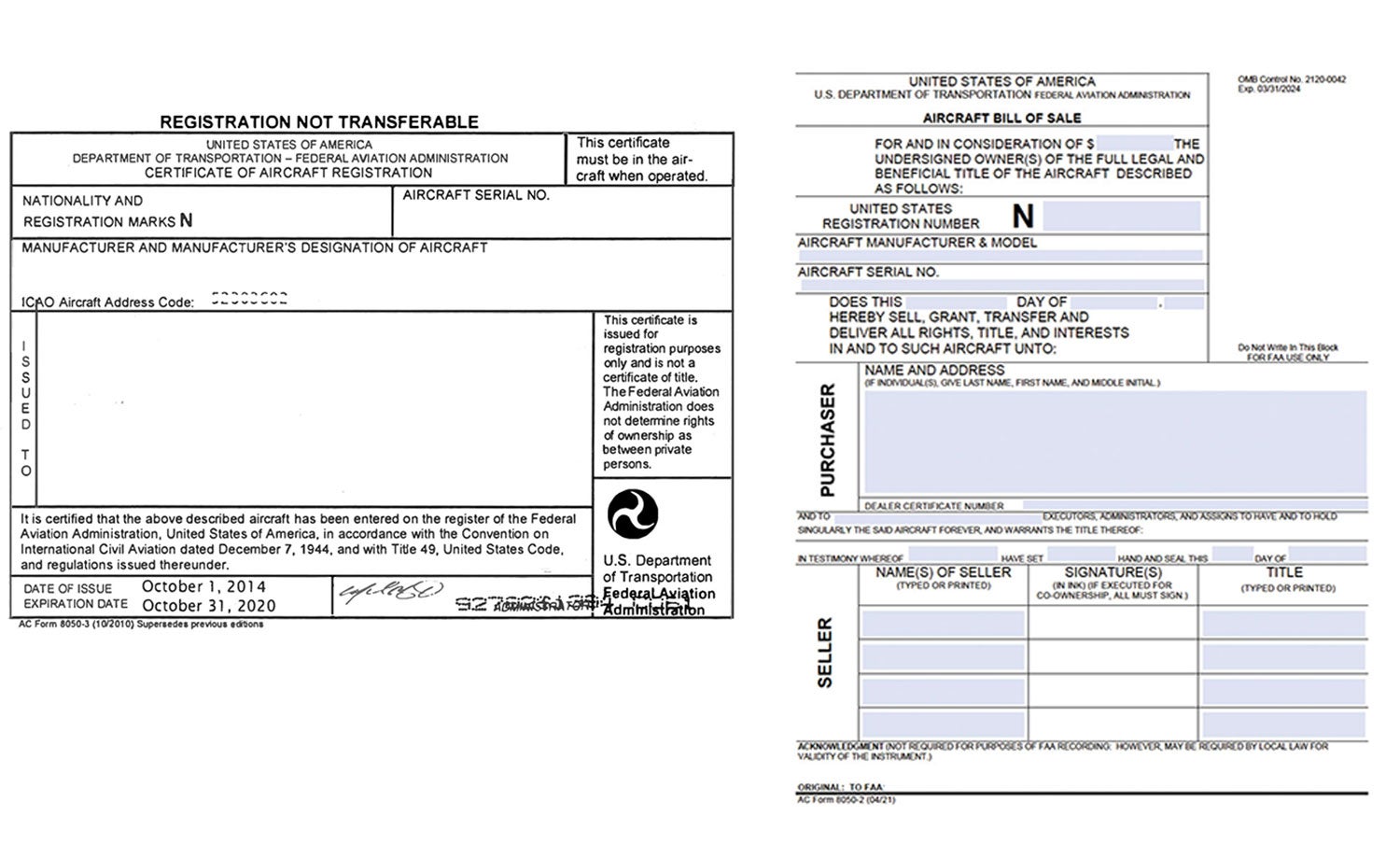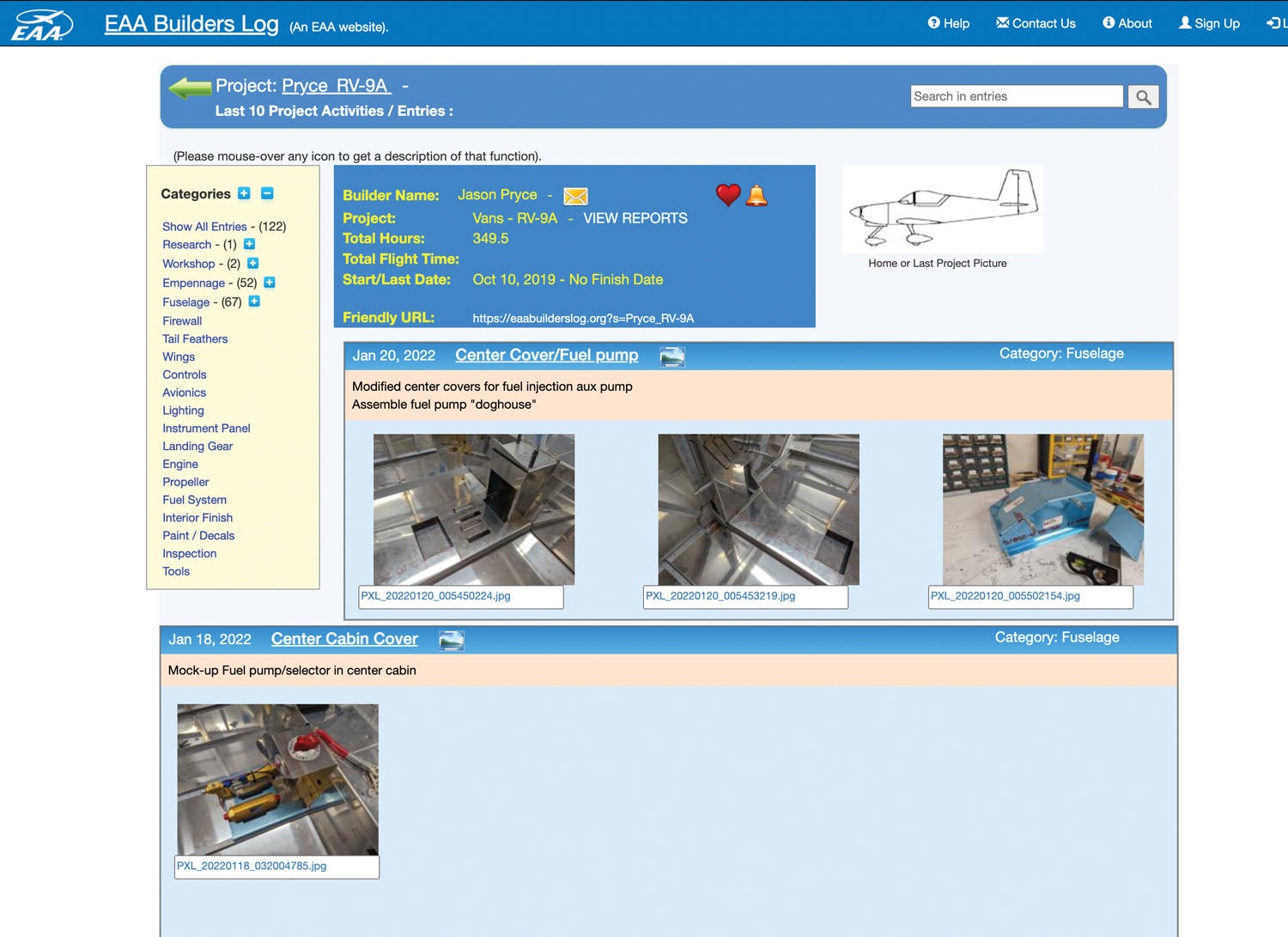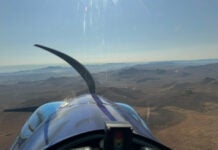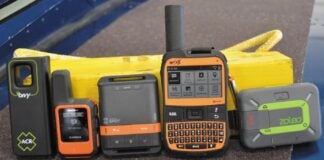 A problem I see often lately is someone who bought a partially completed project and now wants to get it registered and an airworthiness certificate issued, but they don’t have the paperwork from the previous builder or builders.
A problem I see often lately is someone who bought a partially completed project and now wants to get it registered and an airworthiness certificate issued, but they don’t have the paperwork from the previous builder or builders.
Registration
To get a plane registered, you will need to have a bill of sale from the manufacturer to the first owner, a bill of sale from each subsequent owner and a bill of sale from the seller to you. Every time a project changes hands, there should be a bill of sale from the seller to the next owner. This can get rather messy if the kit you are buying has passed through several hands. Ideally, the bill of sale is on the FAA Form 8050-2, but that is not an absolute requirement. If the kit started as plansbuilt (not a kit) you would need the first builder’s paid receipts for major components and then bills of sale for the project from all subsequent owners.
The bill of sale from a manufacturer is usually pretty straightforward, with this caveat: the kit maker will only issue a bill of sale to the original kit buyer, not any subsequent owner. If the manufacturer is no longer in business, the FAA will usually accept a letter of explanation stating that it is not possible to get a bill of sale because the company is no longer in business. This does not always go smoothly, however. In my case, I bought a GlaStar project and asked Glasair Aviation, the successor company to Stoddard-Hamilton, to sign a bill of sale for me. They declined to do so, forcing me to hunt down an officer of the original company to get his signature on a bill of sale.

The point is you need to have bills of sale for all transactions between you and the original kit manufacturer or original plansbuilt builder. This is called the chain of title or ownership. If you are missing one or more of those, expect to get a lot of grief from the FAA Registration Branch, grief that may well include refusing to register your plane.
If someone along the way registered the project, getting bills of sale before it was registered is eliminated. In any case, buying a project without a complete chain of title is risky business. I strongly recommend against it. You will also need a form 8050-88 Affidavit of Ownership to register your plane, but this can be completed entirely by you. It does, however, need to be notarized. The DAR cannot begin the airworthiness process until your plane is registered!
Builder’s Log
A big part of the DAR’s job is to determine whether or not your plane was majority amateur-built. The primary tool for making this determination is the builder’s log. You will need to collect the builders’ logs from the previous owners roughly covering the work they did. If these are not available, you may have trouble convincing your DAR that there is sufficient evidence to make a determination of amateur-built status.

This can also present a problem when you go to apply for your repairman certificate from the FAA. You will be pushing your luck with your DAR if there are big gaps in your builder’s log. He may be forced to issue a denial letter or switch you over to Experimental/Exhibition. This is not the end of the world, but it is certainly not the desired outcome.
Some Possible Scenarios
Let’s look at some examples of cases that may occur. For example, the first builder did quite a bit of work on his kit but died before he finished. His widow is now selling the project. She has a number of photos and a few notes that her husband left. She also has the original invoice for the kit but no bill of sale. The kit maker will issue a form 8050-2 to the deceased original builder. His widow can show by means of a will or trust agreement that she is the rightful owner now and will give you a bill of sale and all of the photos and notes. This should be sufficient to register the plane and satisfy the DAR.
Here is another case. The builder, who was the second owner, died. There was no bill of sale from the first owner, who has also died and no construction records or photos of any kind from either builder. The work completed is very well done, and the price is right. Unfortunately, you will have a very hard time registering this plane and a very hard time convincing a DAR that it was amateur-built. This is one you need to walk away from.
Here’s a bizarre case that came to me. The new owner of a plansbuilt plane called me and said he needed to get his plane registered and an airworthiness certificate since it already had 7 hours. The seller told him a DAR could handle all of this for him. Of course, I told him it was illegal to fly an unregistered airplane with no airworthiness certificate. I also told him that DARs don’t handle registration at all. All I can do is help people with advice. A DAR’s official job begins after the registration has been issued. Where this will go is anyone’s guess. At the very least, he is off to a poor start.
Each owner/builder needs to maintain the chain of proof of ownership and amateur-built status. The better job each owner has done, the easier it is going to be to get the plane registered and rendered worthy for an Experimental/Amateur-Built airworthiness certificate. If there are holes in the paperwork that may be possible to remedy, you could consider making an offer to the seller contingent on solving those problems. If the seller is unwilling to do that, it is time to move on.
Conclusion
If you are looking at a project with no builder’s log and no clear chain of ownership, the smart advice is to walk away. If you are looking at a project with a few holes in the chain of ownership and parts of the builder’s log missing, you may elect to make an offer contingent on being able to recover the missing paperwork. If you are buying from the original builder who has a builder’s log and can get the bill of sale for you from the manufacturer of the kit, you have a doable deal. Just be sure to get an FAA bill of sale from the seller and all of his builder’s log material, plans and notes.
Each sale of an airplane project should be made with an FAA Form 8050-2. This form is available online at www.faa.gov/forms. Note that when selling a partially completed project, the word “AIRCRAFT” on the bill of sale form should be crossed out and replaced with “KIT.”














I wish there was a reasonable way to get a certified plane into some form of experimental, so I can update my plane. The STC process is ridiculous.
You can do what you described, you can put your plane in the experimental exhibition category. A friend of mine did that to a C-172, to install a rotary engine. After that the next owner wanted it back in normal category, which meant back to an aircraft engine. And it was a lot of work. It’s easy to take it into experimental, not so easy to get it back.
Dave,
At what point does a collection of parts and material come under the jurisdiction of the FAA and require a “Bill of Sale” to transfer to the next owner? It is not an aircraft until registered with the FAA and becomes legal to fly after DAR inspection and approval.
If I buy a set of plans for an aircraft, buy enough raw material to start the project, buy used instruments from 5 different hangar buddies, landing gear parts from a salvage yard, purchase lead to balance control surfaces from a sporting goods store, grips for the control sticks from the bicycle shop, a 50 year old engine from a wrecked C-150 that passed through 10 owners, tape for my label printer to placard the instrument panel, LED’s from Radio Shack, etc., etc., etc. , what “bill of sale do I need to show the FAA.
Seems to me the FAA only acquires jurisdiction when I register the completed project, certify to be the owner providing model, serial #, and N #. Aircraft “ownership” is required to be registered but since when PARTS? If only”kit” builders need “bill of sale” and I don’t, why are their requirements different than mine?
Sounds to me like some over-zealous federal employees with their own interpretation of the regs, much like the DAR that gave my friend a designated phase 1 test area and restricted T.O. and landing to home airport only. When he went for his mechanics license I told him to have that restriction removed, it’s not in the regs. When he confronted the FSDO the rep disappeared to the back room and came back 20 minutes later with a new copy for phase 1 testing with that restriction removed. Some of these folks will make up their own rules if you don’t challenge them.
I suspect the TAX man will have their own rules to get their money but that’s outside the jurisdiction of the FAA.
You bet. The Louisiana Dept of Revenue regularly goes thru the FAA A/C database checking on aircraft of all type to be sure the sales tax has been paid and they will surely come after it. They don’t want more than than they are owed, but they do want every penny that they are owed.
All those receipts you mention for the various parts probably have more to do with determining the project was amateur built and complies with the 51% rule to the FAA. I wouldn’t bother saving receipts for the little stuff, but if plans built, I’d save receipts for the big items. like engine and prop, radios, wheels and brakes, the materials that went into the planes structure like the wings and fuselage and tail. They probably are trying to determine that the builder applying is actually the builder, instead of someone who bought a partially completed project that was close to being finished, and just said he built it all. Which makes a mockery of the regulations. Although there are a lot of completed and flying homebuilts where the owner/builder paid a pro shop to build it, put himself down as the builder to get the repairman certificate, and those slip by if all the paperwork is in order.
Why is a bill of sale even requested to register an experimental. It’s never been owned by anyone as it’s never been an airplane. Ownership is registered using AC Form 8050-88 (09/10) Supersedes Previous Editions
AC Form 8050-88 (09/10) Supersedes Previous Editions
AFFIDAVIT OF OWNERSHIP FOR AMATEUR-BUILT AND OTHER
NON-TYPE CERTIFICATED AIRCRAFT
(does not include light-sport)
Applying for a mechanics license is a totally different and independent issue and requires proof of building, in most cases. Any number of proofs may be required at the discretion of the DAR or FSDO from photos, receipts, or even an interview. I got mine over the phone 18 years ago.
Remember, we’re dealing with a government agency. Whatever works for you in any given situation. I’ve dealt with FSDO employees that didn’t even know their own rules in the “second pilot rule”. I was told that’s only for multi-engine aircraft and that was after the rule had been in place for more than a year. Imagine, the pilot is not capable of maintaining control of the aircraft on a first flight so they authorize a second pilot to be exposed to danger. They made it “legal” to kill two pilots with one crash. Go figure. And the second pilot regulation is another 25 page government regulation.
Larry Flesner
Great words of advice.
I have seen this problem first hand with several builds. I am constantly amazed, but not in a good way, by the number of buyers and builders who do not read the regulations, advisory circulars, and orders that the FAA publishes or read the numerous articles in both Sport Aviation and Kitplanes magazines that have covered this topic.
A great deal of knowledge can be gained from reading these publications, whether it be from the FAA or those two named magazines. Besides this author, articles by Vic Syracuse, Lisa Turner, and Mel Asberry should be required reading for builders and buyers of amateur built aircraft.
Hi Dave,
The question I have is for a scratch builder. A friend of mine and I ( who are both A&P-I.A. mechanics) are building an International Formula 1 racer from scratch. We have both Cassutt and Snoo-sho plans but are used for reference only (we have changed the fuselage tubing and details). Our wing and flying surfaces are all our own design from carbon fiber as well as the fuselage shell, cowling and canopy. I will be using an engine made up from various parts I have acquired from my aircraft maintenance business from 30 years of ownership. I also have been saving material left over from repair jobs in the past. I did not save the receipts for all of the above.
So if I fill out an 8050-88 affidavit of ownership and an 8050-1 registration form with a “N” number on the “N number availability list” should I be OK?
After reading Dave’s article, I took a look at the paperwork I received from Van’s with my RV-10 empennage, wing, fuselage, and finishing kits. None resembled a bill of sale, though I do have invoices for each kit and a builder number assigned. Are these the documents I need or should I expect or pursue something else?
Vans will send you an FAA bill of sale upon request. Invoices for kits or kit parts are not sufficient for the FAA.
Two E/AB planes certified by me. Both plans built. No bill of sale from anyone. First one inspected by the FAA, second one by a DAR only because the FAA said they CAN”T do them anymore. Only thing I had to claim is that SOMEONE built more than 51% (came out in the 95-98% area) no problems with friends that built kits that have been thru 3 and 4 prior owners.